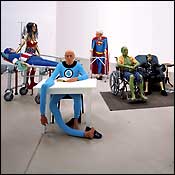
The crowd-pleaser in the Whitney Museum’s The American Effect: Global Perspectives on the United States, 1990–2003 is a nursing home for superheroes. In this life-size tableau by the French artist Gilles Barbier, an aged Catwoman sprawls in an armchair watching old TV clips. Superman dodders about with a walker. Captain America, attended by the decrepit Wonder Woman, lies on a hospital gurney attached to an IV. As a work of art, Nursing Home is essentially a one-liner—the punch line about America could hardly be more obvious—but it’s also very funny. That makes it a standout in an exhibit that, with a few significant exceptions, is a nursing home for platitudes about America.
Organized by Lawrence Rinder, “The American Effect” contains work by 47 artists (and three collaborative groups) from 30 countries. The wall text states that the show presents “a spectrum of views from adulatory to critical.” In fact, the perspectives are overwhelmingly critical; any implication otherwise is preposterous. The only vigorously optimistic piece is by Bodys Isek Kingelez, from the Democratic Republic of the Congo. Created in the aftermath of 9/11, his New Manhattan City 3021 presents lower Manhattan as an architectural fantasia: New York will eternally reinvent itself. Most of the art on display addresses evil American isms, such as consumerism, militarism, and imperialism. A Filipino artist, for example, depicts William McKinley clasping a Filipino baby. The president’s fingernails are eagle talons; a gun pokes from his sleeve. Two Japanese artists separately criticize America’s historical treatment of their country. One shows World War II–era Japanese planes attacking New York City. According to the wall panel, this reflects, among other things, “lingering resentment over America’s devastation of Japan.” (Do the same artists explore Japan’s contemporaneous fascism, imperial ambitions, devastation of China, and attack upon Pearl Harbor?) Even the romantic theme of “on the road” becomes, in this exhibit, a soured American dream.
This negative perspective is not by itself a problem. The United States may have much to answer for, and a superpower inevitably arouses resentment. The problem is rather that most of the art is neither good nor original. The same themes have already been endlessly explored and exploited by American artists, often using the same methods on view here. In most cases, the art is just a diagram or illustration of a political cliché. Again and again, the obvious is rediscovered. One artist has taken the trouble to highlight every mention of South Africa in the Washington Post (liberal) and the Washington Times (conservative) since August 2001. The revelatory point? The American media “filters our perception of the world.” Even the satire is heavy-handed. During the great elephant-poop affair at the Brooklyn Museum in 1999, Mayor Giuliani did a superb job of parodying himself. He became an old maid in pants. An American boob. In this exhibit, however, a Chinese artist presents the mayor as a smiling Maoist tyrant. Yeah, right.
Still, the show contains a few strong works that escape the usual boilerplate. In his evocation of the Battle of the Little Big Horn, Ousmane Sow, a Senegalese, has created large writhing figures that appear torn from the sinews of the earth; Custer’s eyes are a deadly blue, like the reflection of an empty sky. The Norwegian artist Jannicke Läker has made an emotionally piercing video of her encounter with an “Aw, shucks” American visiting Europe for a family reunion. She coaxes the nice doofus into her apartment—“I’d never do this in Kentucky,” he says—and, holding the camera to her eye, seductively persuades him to take off his shirt and dance awkwardly to some music. (The work has a stinging punch line.) The most powerful piece comes from Belgrade—Zoran Naskovski’s Death in Dallas. In this video, Naskovski pairs footage of John F. Kennedy’s life and assassination with a Balkan ballad about the tragedy sung to the accompaniment of a traditional instrument called a gusle. The singer’s mournful chant—“The eleventh month it was and Friday”—sounds as ancient as Homer. Time seems to collapse upon itself: For a moment, there’s nothing new in the New World.